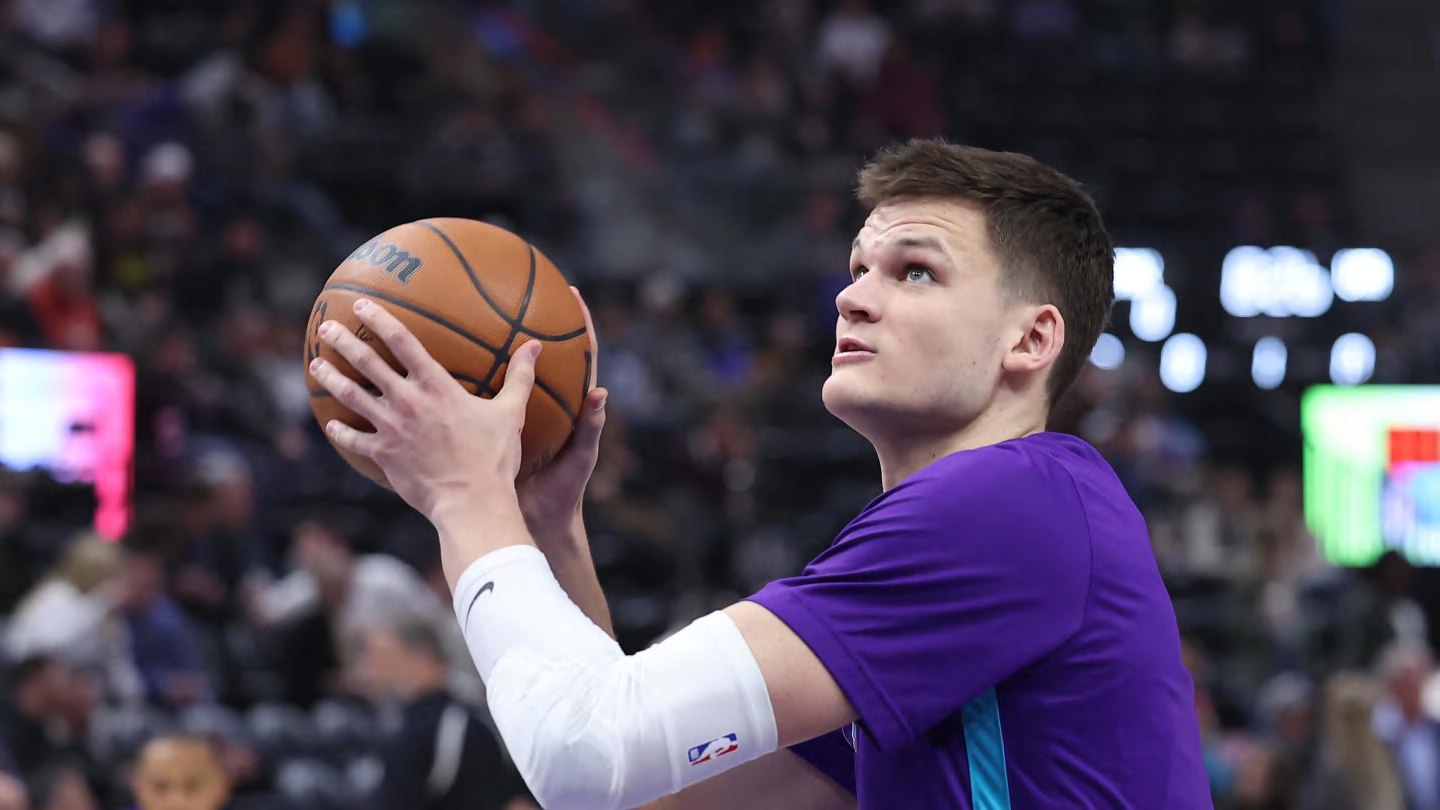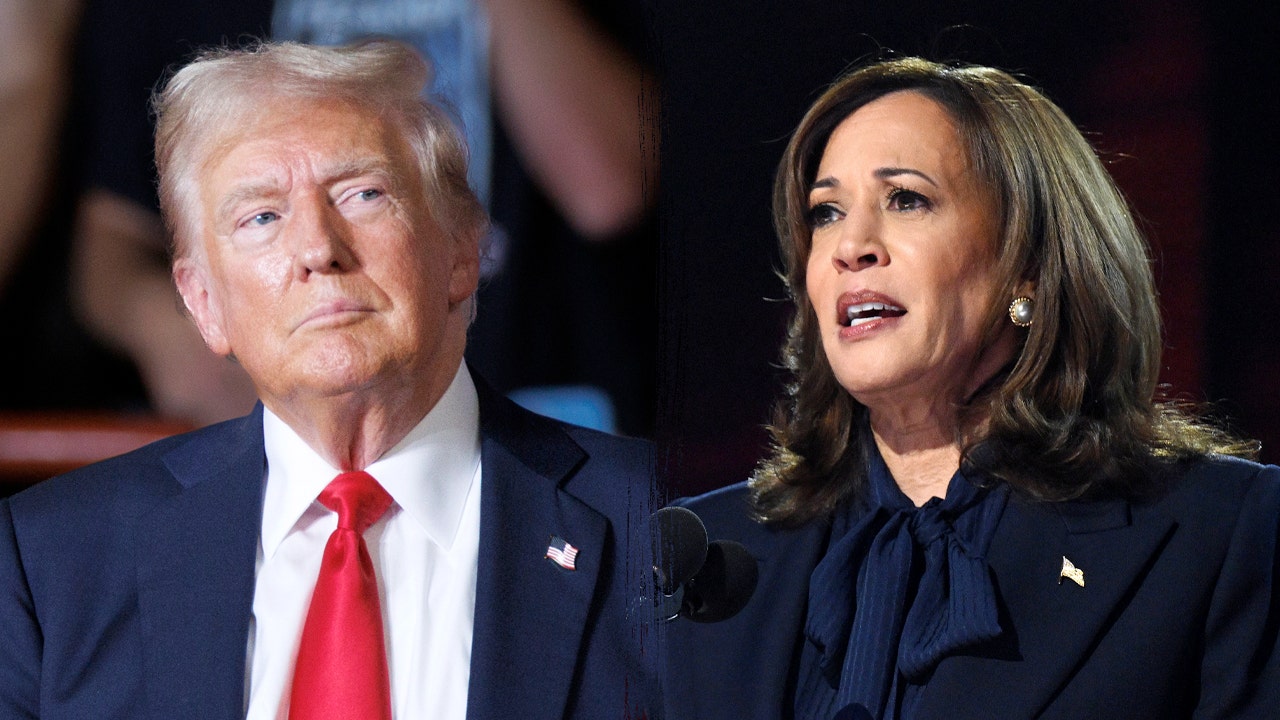Sports
Netflix teases Part 2 of 'Simone Biles: Rising' docuseries, set at Paris Olympics

When the first part of Simone Biles’ Netflix docuseries aired last month, its ending was still unwritten. Now, the script is in.
“Simone Biles: Rising” Part 2, premiering Oct. 25 on Netflix, will follow the most decorated gymnast of all time to the 2024 Paris Games, where her storied comeback culminated in Olympic gold, Netflix announced Wednesday.
Netflix and Biles jointly promoted the docuseries’ final two episodes in a Wednesday Instagram reel spoofing the streaming platform’s show “Emily in Paris.” In the 20-second clip, the G.O.A.T. cheekily sips from a Champagne flute — Eiffel Tower in the background — and snacks on French pastries, quipping, “Ever since I moved to Paris, my life has been chaotic and dramatic and complicated.”
Although the teaser was inspired by fiction, Biles’ sentiment holds truth.
The first installment of “Simone Biles: Rising,” released July 17, pulled back the curtain on Biles’ widely criticized withdrawal from the 2020 Tokyo Olympics (held in 2021 due to the COVID-19 pandemic) after an episode of “the twisties” — a dangerous phenomenon in which gymnasts lose their perception of their body mid-air — led to an infamous botched vault routine.
People called her a “quitter” who had nothing more than an off day, Biles said in the docuseries. But at her level, where much of the sport involves “trying not to die,” pushing through wasn’t an option.
“Your body can only function for so long before your fuses blow out,” she said, adding that she now sees her struggles in Tokyo as a “trauma response.” (Biles is among the hundreds of athletes who survived sexual abuse by Larry Nassar, the former team doctor of the national gymnastics team.)
When it came to any traumatic experience, Biles said she told herself to “shove it down, wait until my career’s done, [then] go fix it.” Inevitably, she continued, that caught up to her.
After Tokyo, she resolved to take time off to address her mental health — the first steps on a winding road to recovery.
“I knew it would be a long journey. But to me, I wasn’t done,” Biles said. “I get to write my own ending.”
In Paris, at 27, Biles became the oldest American woman to compete in Olympic gymnastics in 72 years. She left the Games with three gold medals and one silver — and reclaimed the all-around title.
She seemed to celebrate her triumph Thursday, sharing on her Instagram story that she’d upgraded her older black Mercedes G-wagon to a shiny white model.
“Out with the old,” she captioned a photo of her old wheels, writing “In with the NEW” over the image of her new car.

Sports
Olympics drove interest in women's sports cards, Snoop Dogg pins and more

The Olympics are an event that can fuel growth in interest and popularity, not just for a given sport or individual athlete, but for an array of collectibles, as well. The global nature of the Olympics, the way they cross-pollinate fans of different sports and draw in very casual or even non-sports fans — it’s something that can supercharge demand.
Take basketball for example — the men’s gold-medal game between the U.S. and France averaged 19.5 million viewers in the U.S. alone, whereas the most recent NBA Finals averaged 11.3 million viewers. The women’s gold-medal game drew 7.8 million viewers in the U.S. (at 9:30 a.m. ET), and last year’s WNBA Finals averaged 728,000. While that sudden influx of new eyeballs can produce a brief and immediate surge of interest that just as quickly evaporates, it can also be the foundation for longer-term growth in some cases. It can be an introduction that creates new fans and collectors.
With that in mind, let’s look back on the 2024 Olympics using insights from eBay:
Athletes (and rappers) who saw a surge of collector interest
The most searched Team USA men’s basketball players within eBay during the Olympics were LeBron James, Anthony Edwards and Steph Curry. James and Curry’s places there shouldn’t be surprising, given their status as legends of the game and how they came through in big moments for Team USA, but Edwards being searched at that level within a marketplace (rather than just on a more general interest platform like Google) is noteworthy.
The day Team USA beat Serbia in the semifinals, Edwards’ ungraded 202o Panini Prizm silver card (a popular parallel in the most popular NBA set that has a bit more favorable supply/demand balance than his plentiful Prizm base rookie card) returned to the price level it reached at the start of the NBA Western Conference finals in May (around $320), when he was one of the postseason’s top performers to that point, up from the sub-$200 level it dropped to in late June/early July. Edwards didn’t produce a standout performance in the semifinal or final of the Olympic tournament, so there has been another decline, but the card remains higher than the lows it hit after his NBA playoff elimination. He’ll need to take another leap forward this season and have better showings in key moments in order to further grow the level of collector interest in him, though.
Steph Curry (left) and Anthony Edwards after receiving their gold medals. (Photo: DAMIEN MEYER/AFP via Getty Images)
On the women’s side, the most searched Team USA players on eBay were Sabrina Ionescu, Breanna Stewart, Diana Taurasi, and Kelsey Plum. Taurasi didn’t play in the gold-medal game and averaged just 1 ppg for the tournament, but she won her sixth gold medal — a new record for the sport. Noticeably absent from that group is A’ja Wilson, who was named MVP of the tournament and is also the clear favorite to claim a third WNBA MVP trophy this season. There have always been players who far outperform the level of collector interest in them, but this looks like a generational talent/all-time great being seriously undervalued.
The Olympics provided a boost to women’s sports collectibles though. Katie Ledecky sales grew throughout the Olympics, peaking with a new all-time high of $4,037 for her 2024 Topps Chrome Ledecky Legacy autographed superfractor (a one-of-a-kind parallel, pictured below). Two Simone Biles cards sold for more than $2,000 each. But perhaps most impressive was that two superfractors, one autograph and one patch, from the 2024 Topps Chrome Olympic set of Ilona Maher, star of the USA rugby bronze-winning team, sold for $1,743 and $1,500, respectively — not too far off from those sales for Biles, a more established star in a sport that’s more popular in the U.S.

Assessing long-term value of Olympic athletes in sports that don’t hold annual mainstream interest in the U.S. is always difficult. Ledecky and Biles could hold strong since the former is tied for the most career Olympic gold medals among female athletes (nine) and the latter isn’t far behind (seven) and both have more of a cultural presence. Their legacies are set. But unless rugby undergoes a dramatic rise in popularity, it seems difficult for Maher to have the same staying power. (That said, monetary value often isn’t the primary concern for collectors — particularly if they never intend to sell a given item — and waiting for more buyer-friendly conditions when one-of-a-kind items become available often isn’t possible.)
The USA women’s soccer team won gold thanks in part to the trio of Sophia Smith, Trinity Rodman and Mallory Swanson (or “Triple Espresso,” as they’ve nicknamed themselves), who all scored big goals and all saw big eBay search spikes when they did. Searches for Swanson jumped 580 percent on eBay (compared to the previous week) after she scored the gold medal clinching goal against Brazil. Cards from the 2024 Topps Chrome Olympic set that bear autographs from both Smith and Swanson (pictured below) have drawn particular interest, with peak sales prices of $628 and $700 on August 18, a week after the tournament closed.

A couple of non-USA athletes who also had big search spikes were the men’s tennis finalists. After he won the gold medal, searches for Novak Djokovic rose 450 percent compared to the week prior and searches for silver-medalist Carlos Alcaraz rose 80 percent. These are two of the biggest names in an already popular sport, so the fact that Olympic success could provide a surge in marketplace searches is a testament to the new wider audience the event brings. With the U.S. Open now underway and a newly released Topps Chrome tennis set, there will be an opportunity to retain some of that interest.
The Olympics can also blur the already sometimes fuzzy lines between sports and non-sports collectibles. Snoop Dogg’s custom Olympic pins went viral, resulting in global eBay users to search “Snoop Dogg pin” almost 140 times per hour on July 30 and 31. And since the 2028 Olympics will be in his hometown of Los Angeles, this may not be the last we hear of Snoop Dogg Olympic pins.
Coco Gauff’s got the @SnoopDogg #Olympics pin 🤩#Paris2024 | #tennis pic.twitter.com/W6zRDFoeae
— ITF (@ITFTennis) July 29, 2024
Industry views
As The Athletic continue to grow its collectibles coverage, we’ll include perspectives and observations from around the hobby. Since this is our first time diving into eBay insights, we begin with the executive who oversees their collectibles operation.
Interest in the Snoop pin and Olympic pins in general points to the variety of collectibles that have gained in popularity in recent years.
“Obviously trading cards is a huge, huge piece of it, but the thing that’s fun is you see new categories that emerge and sometimes those things disappear again and sometimes they stick around,” eBay vice president and general manager of global collectibles Adam Ireland told The Athletic during the National Sports Collectors Convention last month. He cited sealed vintage electronics and Type 1 photographs as examples.
“Someone once told me that it’s sort of that 25-year window when you start hitting nostalgia and that’s the point where people have got the money now and are spending on things that tie them back to those happy childhood days,” he added, saying that they’re seeing Teenage Mutant Ninja Turtles merchandise take off as it now fits that window for older generations, while the franchise’s new movies and shows draw in a younger audience as well.

Chad Ochocinco draws a crowd to an eBay Live broadcast at The National. (Photo courtesy of eBay)
Trading card games, which can hit on that nostalgia appeal, are also driving a lot of interest. Ireland says he is “super bullish” on them. “Obviously (Disney) Lorcana has been another big boost to that area, but you’ve still got Pokemon going strong, some of the recent Magic: The Gathering releases have been really, really successful. … (Lorcana) and Disney collectible pins, a lot of historical artifacts, toys, vinyl – there’s just so many categories (in the collectibles space), but you do find that sports as a single thing becomes the largest piece.”
“King of Collectibles: The Goldin Touch,” the Netflix series about Goldin Auctions, which eBay recently acquired, is something Ireland sees as helping to broaden interest in collectibles.
“It’s easy to think about collectibles as a niche area, but they hit number four on the Netflix charts and that’s just going to bring more and more people into the hobby,” he said. “It’s amazing how many people I’ve spoke to about and they’ve been like, ‘Oh my wife watched the show and now she understands why I get excited about this stuff.’ And so from that point of view I think it’s just going to open it up, it’s going to democratize it more.”
The Athletic maintains full editorial independence in all our coverage. When you click or make purchases through our links, we may earn a commission.
(Top photo: Harry Langer/DeFodi Images via Getty Images)
Sports
Trump poses for photo with Raiders stars Maxx Crosby and Gardner Minshew in Las Vegas
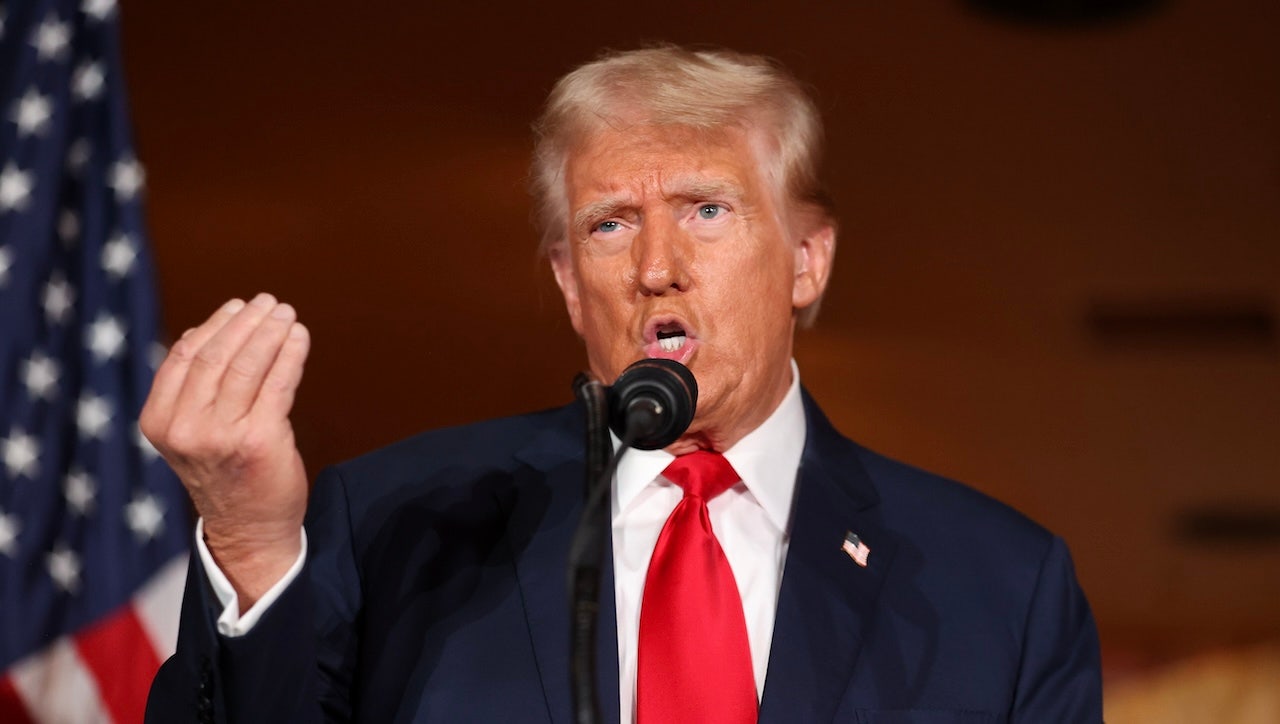
Three Las Vegas Raiders players posed for a photograph with Former President Trump Friday.
Defensive end Maxx Crosby, quarterback Gardner Minshew and wide receiver Alex Bachman posed with Trump in a furnished room in Las Vegas in a photo posted on X by The Daily Caller’s Henry Rodgers.
Crosby, one of the Raiders’ biggest stars, expressed his fandom of Trump shortly after a July 13 assassination attempt on the former president in Butler, Pennsylvania. Crosby referred to Trump as the GOAT in a post on X that day. Crosby has spent his entire career with the Raiders.
Minshew is a newcomer to Las Vegas, having just signed with the Raiders in the offseason. Minshew was named the team’s starting quarterback by head coach Antonio Pierce.
Bachman, a former New York Giant, was projected to contend for a spot on the active roster as a backup or the team’s practice squad but still managed to work his way into the photo with Trump.
Quarterback Gardner Minshew of the Las Vegas Raiders warms up before a preseason game against the Dallas Cowboys at Allegiant Stadium Aug. 17, 2024, in Las Vegas. (Chris Unger/Getty Images)
Trump was in Nevada Friday for a campaign event, where he touted his “no tax on tips” policy. He also thanked former 2024 opponent Robert F. Kennedy Jr. for his endorsement after Kennedy ended his bid as an independent candidate.
DOES KENNEDY’S DEPARTURE FROM THE 2024 RACE HELP TRUMP MORE THAN HARRIS?
“We just had a very nice endorsement from RFK Jr. Bobby. And I’ll be talking about that. We’re heading out right after this. We’re going to be going to Arizona. We’ll be talking about that and a lot of other things too, but I just want to thank everybody, and I want to thank Bobby. That was very nice. That was really very — that’s big. He’s a great guy, respected by everybody,” Trump said at the event.
The former Democrat spoke a couple of hours before Trump was scheduled to hold a campaign event in nearby Glendale, Arizona. The Trump campaign on Thursday announced the former president would be joined by a “special guest,” which sparked speculation of a Kennedy endorsement.
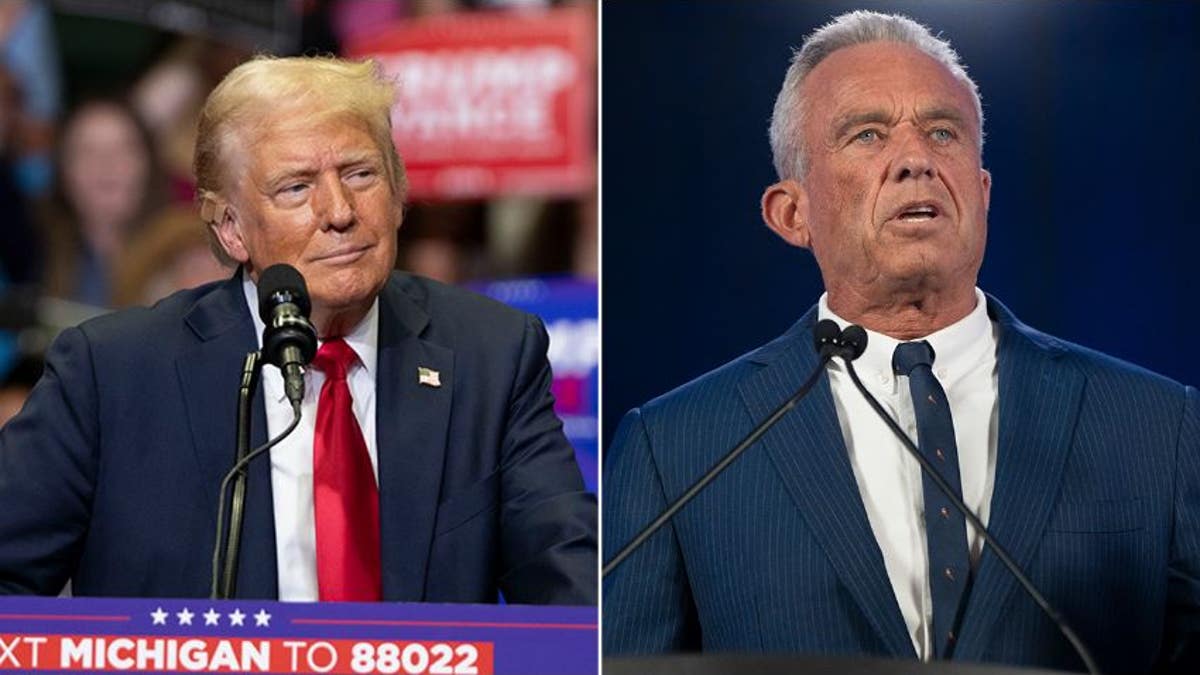
Former President Trump and Robert F. Kennedy Jr. (Getty)
Las Vegas has long been one of the cities in which Trump’s businesses have held economic and cultural prominence. In 2008, Trump International Hotel Las Vegas officially opened as the tallest building in Las Vegas. Trump partnered on the 1,282-room, non-gaming project with Las Vegas casino owner and friend Phil Ruffin. The developers have closed more than $400 million in unit sales since the luxury high-rise opened in 2008, property records show, according to the Review Journal.
Nevada has voted for a Democrat in every presidential election since 2008. However, Trump has held a polling lead in the state for much of the 2024 campaign cycle. Since 1980, the presidential candidate who carried Nevada has won the election 10 out of 11 times. The only exception was in 2016, when Trump lost the state to Hillary Clinton but won the election.
The Raiders open the season Sept. 8 in Los Angeles against the division rival Chargers.
Follow Fox News Digital’s sports coverage on X, and subscribe to the Fox News Sports Huddle newsletter.
Sports
'I consider myself lucky': Dominic Thiem and the agonising what-ifs of tennis

The greatest moment of Dominic Thiem’s tennis career came in an eerie vacuum in front of more than 20,000 empty seats.
As he collapsed to the ground after four hours on court against Alexander Zverev in the 2020 U.S. Open final, the noise he heard was the whirr of camera shutters and a smattering of applause, not the cacophony that normally greets a singles champion inside Arthur Ashe Stadium in New York City.
It didn’t matter. He had finally done it. He had his Grand Slam title.
It was not a final for the purists, regardless of the context, as tennis returned from a Covid-19-enforced hiatus to play before rows of empty seats. Thiem and Zverev were manacled by the weight of history and opportunity, first separately, and then both at once, their tennis labouring to reach something as yet unachievable. Rafael Nadal and Roger Federer had skipped the tournament; Novak Djokovic was defaulted in the fourth round for accidentally hitting a line judge with a ball. Having lived under the crushing dominance of that ‘Big Three‘, suddenly, there was a path.
Things started terribly that day for the Austrian, who had dropped only one set in reaching the final. He lost the first two against Zverev and looked set for a crushing defeat.
“I already felt before the match that something was not right,” Thiem tells The Athletic in a video interview from his home in Austria. “I wasn’t getting into the zone or the flow. And that’s how the first two sets went — they were way too tense, too nervous. Sascha (Zverev) was playing really well.
“The pressure was so high. I was thinking back to my previous finals. Maybe it’s less pressure to face the greatest players of all time. Because the U.S. Open, I had to win (in those circumstances), and that was really tough.”
It’s Dominic Thiem’s moment.
The point that made him a Grand Slam champion 👇 pic.twitter.com/uYMplH3TF7
— US Open Tennis (@usopen) September 14, 2020
Before winning in your fourth Grand Slam final, you have to lose three, and Thiem fell just short of two of the toughest feats in men’s tennis in all of them. He lost two French Open finals to 14-time Roland Garros champion Nadal, and one Australian Open to Djokovic, who has lifted the trophy in Melbourne 10 times. Along with Andy Murray and Stan Wawrinka, no player suffered from the supremacy of Nadal, Djokovic and Federer more than he did.
“Every Grand Slam final felt like it could be the last one, because the journey is really tough,” Thiem says. “You have to beat great players, you have to stay healthy. Many, many little things have to come together. When I played Sascha (that day in New York), it was like now or never.
“When I was two sets down, luckily I released a bit and he also started to think a bit more that he’s very close to the title.”
After Thiem clawed back that two-set deficit, Zverev served for the championship at 5-3, but Thiem broke to stay in the contest. The match went to a final-set tiebreak.
It remains a tough watch almost four years on.
In one corner is the exhausted Thiem, drenched in sweat, battling an Achilles tendon problem and suffering so badly from cramp he struggled to serve. In the other is Zverev, so gripped by nerves he could only muster a 68mph (109kph) second serve when down match point, as well as hitting two double faults.
Thiem won by seizing the initiative, ripping away a couple of decisive forehand winners. His fearlessness remains one of his defining characteristics, and it came to the fore at the most critical moment of his career. Former world No 4 Tim Henman said in commentary for Amazon Prime: “I’ve never seen anything like that. The legs had gone, but the belief hadn’t.”
The Austrian finally claimed a Grand Slam title at the fourth attempt (Matthew Stockman/Getty Images)
Thiem’s moment had finally arrived but in the most surreal circumstances imaginable, with no fans in the crowd, just a small collection of tournament staff.
That U.S. Open was supposed to herald the start of something exciting for Thiem. Instead, it marked the beginning of the end.

This month, Thiem is back in New York as a wildcard, where he will face home hope Ben Shelton in the first round.
This will be his last Grand Slam tournament, and he is likely to be out of it by the time he turns 31 on September 3. Thiem has won just one of his eight ATP Tour matches in 2024, and is now 209th in the world rankings. This lack of competitiveness — defined by the after-effects of a serious wrist injury from 2021 — is why he is calling it a day. He has no interest in carrying on in such a diminished state, and does not think surgery would change anything.
“There wasn’t a particular moment I decided (to retire) but towards the end of last year I was working hard, putting in a lot of hours, doing a good job, giving it my all, and the steps in the right direction were just not satisfying for me,” he says. “I was not playing well enough, especially when I was comparing myself to three, four, five years ago.”
A wrist injury is just about the worst a tennis player can suffer — it is at the end of the kinetic chain and the part of the body most connected to the racket. Although it can be traced to an innocuous match against Adrian Mannarino in Mallorca, it came from the thrashing of the ball that was Thiem’s signature, as well as the effort of facing the greatest players of all time, largely all at once.

Thiem’s flashing, brutal groundstrokes were his signature (Julian Finney/Getty Images)
Thiem was not a tennis prodigy everyone assumed would win Grand Slams, as was the case with other children of the 1990s such as Zverev, Grigor Dimitrov and Stefanos Tsitsipas. He became the first of two players born in the 1990s to win a major — succeeded by Daniil Medvedev — thanks largely to unrelenting hard work. He became synonymous with the post-Wimbledon clay-court swing, a time when most top players put their feet up. In 2015, he set a personal record by entering 29 tournaments — 13 more than year-end world No 1 Djokovic.
With his youthful look, throwback 1990s haircuts, and the way he would occasionally berate himself after a missed shot, Thiem possessed a vulnerability that endeared himself to tennis fans.

It took a toll, especially as a mere mortal trying to compete with the sport’s three demigods.
“That contributed to the injury, definitely,” he says. “I was competing with the three greatest of all time. That was intense.
“But also, all the years before I always had a big load and intensity in my practice. That’s something the doctor and many other people said: that at one point the wrist broke because of all the shots I did, all the hard practice I did all those years before.
“I was always striving to get better and get even closer to the best players in the world.”
Rather than cursing his luck, he feels privileged to have faced the three greatest male players of all time in the biggest matches. Thiem had 35 meetings with the Big Three, boasting a 16-19 win-loss record, including beating Federer in five of their seven encounters.

Thiem defeated Federer to win Indian Wells in 2019 (Sean M. Haffey/Getty Images)
“I consider myself lucky to be in that timeline with the Big Three and all the other great players,” he says. “I came up into the top 100 way later than most; they came up when they were, like, 18, whereas I was 20 and a half. I didn’t think it would be possible that I’d be a Grand Slam champion and No 3 in the world.”
Thiem’s positive outlook made him one of the most popular players on the ATP Tour over the last decade. When he announced in Rome in May that he would retire on home soil at October’s Vienna Open, there was a palpable feeling of disappointment among the assembled players in the Italian capital.
His good friend Zverev, vanquished in that agonising five-set U.S. Open final, described him as extremely down-to-earth: “He hasn’t changed with success, which sometimes is difficult to do. On the court, the power he had, the way he played — he gave it 110 per cent every time. You could feel that as a player and as a spectator, and that made him very special.
“He’s one of my best friends on tour.”
That final sentiment is familiar — it became a running joke in the locker room that players would invariably choose Thiem when asked who their best pal on tour was.
Even if Thiem was relatively slow to reach the world’s top 100, he made up for lost time.
After reaching the French Open semifinals for the first time, he cracked the top 10 in June 2016. He lost to Djokovic in that semifinal, when he was en route to his fourth straight Grand Slam title. The Big Three brick wall started early.
Thiem grew up on clay, and the slower surface defined and suited his long, wound-up swings — especially on the backhand side. His single-handed backhand, with its mixture of beauty and violence, symbolises his game. Of his 17 ATP singles titles, Thiem won 10 on clay, one on grass, and six on hard courts.
Clay suited the athleticism of Thiem, who played football to a decent level, as a central midfielder, until he was 14. He eventually became the second-best clay-courter in the world, but it mattered little: the best was in a different galaxy. Thiem would twice beat Djokovic at the French Open, only to run into Nadal for three straight years between 2017 and 2019. He lost all three, winning a single set across one semifinal and back-to-back finals.
“The first one (2018), I was a bit overwhelmed from reaching a Grand Slam final,” Thiem says. “Maybe I was one or two per cent too satisfied, too happy already with being in the finals. And I paid the bill for that.”
Nadal won 6-4, 6-3, 6-2.
The following year, having won Indian Wells in the March, Thiem’s reward for beating Djokovic in a two-day semifinal was another meeting with Nadal. The Austrian took the second set to level the match, but Nadal raced away with the next two to claim a 12th Roland Garros title.

Thiem never got the better of Nadal at the French Open (Clive Brunskill/Getty Images)
“That time, I really went on the court with the belief to win,” Thiem says. “I had a great attitude in this match and played really well. But he was just on a different level. It was very painful in the beginning, but it was a great match against the greatest player at this tournament of all time.”

There was more pain at the 2019 French Open, but of a different kind.
The famously easygoing Thiem came off the court to a bizarre incident when he was forced out of the interview room by a furious Serena Williams. The 23-time Grand Slam singles champion wanted to do her press conference as quickly as possible after losing in the third round. A disbelieving Thiem was furious, saying, “What the hell? But it’s a joke, really,” as he was ushered out of the room.
He added that Williams had shown a “bad personality” and he was suddenly catching strays from luminaries, including Whoopi Goldberg. “Don’t blame her, stop being a bonehead,” the actor said on U.S. broadcaster NBC.
Reflecting on the incident now, Thiem laughs. His frustration was partly directed at his own stressful third-round match against Pablo Cuevas — and, there was a happy ending. “Looking back, it’s very funny, because a few weeks later, we met around the Wimbledon practice courts, and Serena came up to me and said sorry. I also said sorry, because I lost it a bit there. It was a very nice conversation.”
The 2019 French Open was his first major after splitting with long-term coach and manager Gunter Bresnik. Thiem replaced Bresnik, often associated with his punishing schedule, with the 2004 Olympic champion Nicolas Massu, who was there for the 2020 U.S. Open win.
Bresnik later sued Thiem for a share of his earnings in the period shortly after they had stopped working together. This was settled out of court in March 2021.
Thiem’s next big chance at a major was the 2020 Australian Open, where he led Djokovic, as formidable in Melbourne as Nadal was in Paris, by two sets to one in the final. He had a point to move up a break in the fourth set but couldn’t convert it and ended up losing in five sets.
Thiem, who beat Nadal en route to the final, believes this was the peak of his career: “That was the best I played; how I was moving, playing attacking tennis, the way I was serving and returning, which was not my biggest weapon. Losing was very painful as I had chances like never before in that final.”

At the 2020 Australian Open, Thiem lost the final to Djokovic in five sets (Cameron Spencer/Getty Images)
Despite his incredible record and the challenges of playing his first three Grand Slam finals against two of the Big Three, Thiem was on the cusp of becoming a nearly-man. Beating one of Federer, Nadal or Djokovic was rarely enough, and they played each other so often that they continuously elevated each other’s level. The recently-retired Murray had a similar experience, losing his first four major finals to Federer (three times) and Djokovic. Thiem says that in retirement, he would like to get together with Murray and some of his other former rivals and “have a really deep conversation” over a beer.

Like Murray, Thiem broke the duck, but because of the pandemic that had turned his triumph into such a surreal occasion, he had no time to savour his victory. That year’s French Open had been moved from its May/June slot to late September/early October, meaning it started only two weeks after his U.S. Open triumph. Thiem reached the quarterfinals, and then the final of the year-end ATP Finals. He seemed on track to kick on — but he knew that something wasn’t right mentally.
“Straight after the U.S. Open, I thought, ‘Wow, it’s going to be so easy, because now I won’t put pressure on myself’. But I needed the pressure, I needed the stress, to be in the zone to play my best. I completely lost that feeling. It was pure emptiness going on court.”
Dimitrov hammered Thiem in the fourth round of the 2021 Australian Open and, after a few months in which he was slowly rediscovering his motivation, the wrist injury against Mannarino ended his season — meaning he couldn’t defend his U.S. Open title.
“I had that inner fire and inner drive again, the feeling to practise with 100 per cent intensity again — then the wrist injury happened,” he says.

Thiem and Djokovic played cat-and-mouse through the years (Tim Clayton/Corbis via Getty Images)
Since the injury, Thiem has never been able to go at full pelt. There have been some good results and entertaining matches — reaching the 2023 Kitzbuhel final in his homeland, and a close three-set defeat to Tsitsipas in Madrid a few months earlier — but he has never sustained any form.
Thiem felt relief in May when he publicly announced his plan to retire — he had been more emotional when the thought first entered his mind late last year. He had retained the belief he could find his old self for some time, but never wanted to go out feeling like it was unattainable.

Thiem showed some of the old ferocity at the 2023 Madrid Open (Javier Soriano/AFP)
“Maybe there would be one act or tournament that would change everything,” he says. “But it just didn’t happen. Even when I had good results, it was more because of the fighting spirit than the playing level. That was always unsatisfying, and it helped with the decision.”

In April, he posted on social media: “I’m not the player of 2020 anymore. I have to deal with the current situation, with the fact that my wrist doesn’t give me the strength it used to.”
The expectation was that Thiem, a two-time finalist, would be given a wildcard for the French Open a couple of weeks after his decision. Instead, he had to try to qualify, losing in the second round but receiving a special presentation on a packed Court Suzanne-Lenglen.
Thiem bears no ill will for the snub, cherishing instead the memory of his farewell on one of his favourite courts and adding: “I was very relaxed, because I had enough time to play myself into the top 100 and have a spot in the main draw. I didn’t take that chance. It was OK.”
Since then, Thiem has lost three straight matches as he seeks one last big performance in New York. While he looks ahead to life after tennis — dreaming of setting up a sustainable football club, like Forest Green Rovers, who play in the fifth tier of English football; starting a family with his partner, the circus performer Lili Paul-Roncalli; maybe commentary; maybe coaching — he knows watching the sport’s leading players, some of them older than him, doing what he used to do will be one of the realities of retirement.
Even that level feels distant now but, as with having to face the Big Three on court, Thiem is excited, not bitter.
To watch matches “without being worried about anything, just to enjoy the sport, which is unbelievably beautiful” is enough now.
And first, there is New York, the site of his surreal, but beautiful moment on Arthur Ashe.
(Top photos: Getty Images; design: Eamonn Dalton)
-

 Ohio1 week ago
Ohio1 week agoOhio taxpayers sent families $966 million for private school tuition: Capitol Letter
-

 World1 week ago
World1 week agoRussia-Ukraine war: List of key events, day 901
-

 Minnesota6 days ago
Minnesota6 days agoReaders and writers: Plenty of thrills and danger in these Minnesota author’s mysteries
-

 Movie Reviews1 week ago
Movie Reviews1 week ago‘Veeranjaneyulu Viharayatra’ movie review: A journey steeped in bitter-sweet memories
-
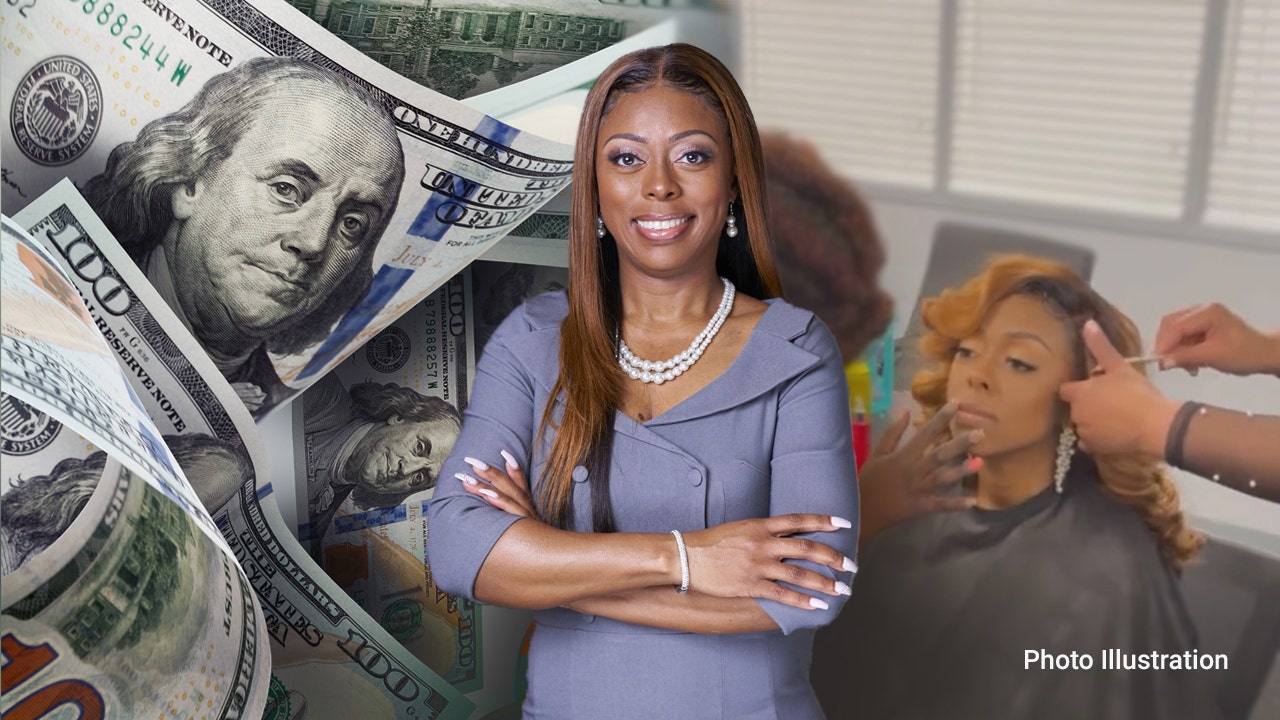
 Politics1 week ago
Politics1 week agoPolice ally of scandal-ridden Mayor Tiffany Henyard indicted on bankruptcy fraud charges
-
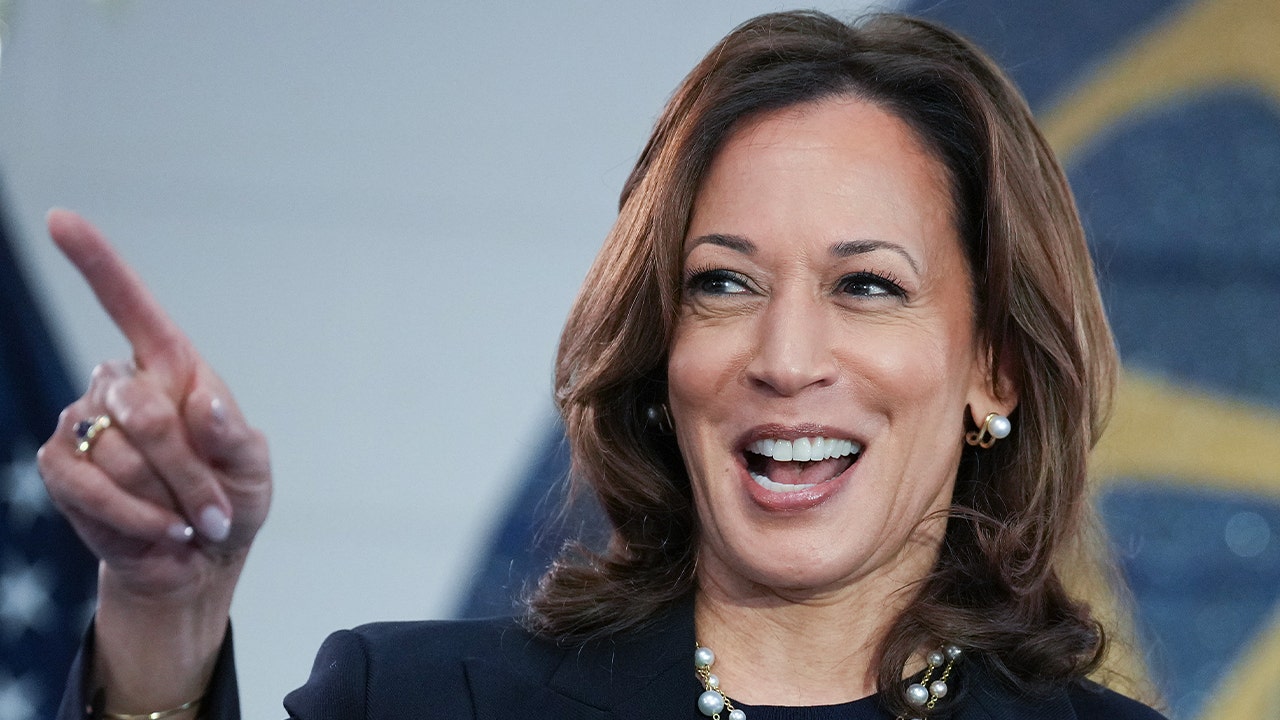
 Politics1 week ago
Politics1 week agoHarris dodging flip-flop attacks as faceless surrogates flip on key positions: 'Playing politics'
-

 News1 week ago
News1 week agoTracking the Swing States for Harris and Trump
-

 News1 week ago
News1 week agoVideo: Biden and Harris Announce Deal to Lower Drug Prices

:focal(0x0:5186x2963)/static.texastribune.org/media/files/d0dda93a49bd8462cb35795437d3b4f2/Harris%20County%20Votes%20AM%20TT%2009.jpg)

